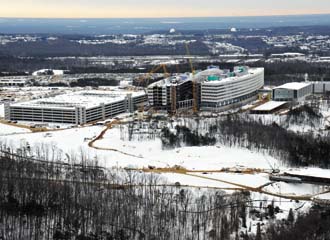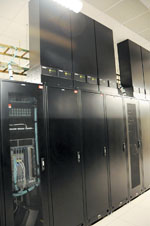Intelligence Embraces Network-Centric Facility
 |
The new National Geospatial-Intelligence Agency (NGA) headquarters being built on the grounds of Fort Belvoir, Virginia, is designed around a network-centric architecture. In this overhead shot, the double-crescent-shaped headquarters is flanked at left by its parking garage and at right by its technology center, which contains most of the servers and support technology for the facility’s infostructure. To the right of and behind the technology center is the building’s power structure. |
A major
A dedicated technology center houses hundreds of servers that provide unprecedented bandwidth to thousands of individual employees. Access across networks is seamless based on security privileges. And, both the external customer community and the internal user community will benefit from built-in redundant capabilities and a flexible architecture that permits easy incorporation of new technologies when they appear.
The home of these advances is the National Geospatial-Intelligence Agency’s (NGA’s) New Campus East (NCE), a $1.77 billion construct that is being built on the grounds of
Seen from above, the NCE resembles a human eye—two shallow-crescent buildings flank a circular structure. The 2.4-million-square-foot facility includes nine diesel power generators in its own central utilities plant that provides backup power as well as advanced liquid heating and cooling. When it opens in 2011, the NCE will accommodate 8,500 people.
Michael Carr, deputy program director for systems at NCE, describes it as the agency’s first purpose-built building. Formerly known as the Defense Mapping Agency (DMA) and later the National Imagery and Mapping Agency (NIMA), the NGA inherited several buildings as it evolved into its current form. These structures never were designed to carry out the functions that define the NGA in this new era of electronic media. The BRAC mandate to move into a new headquarters gave the NGA a chance to design and build a facility that would meet geospatial intelligence needs for the foreseeable future, Carr relates.
From the start, information technology was a major part of that purpose-built design. The building’s network-centric environment is based on everything over Internet protocol (EoIP). Not only does this represent the standardization of the diverse information systems found at various NGA facilities, it also clears the way for growth as new information capabilities are added to the agency’s menu. “It is our chance to do it right from the beginning,” Carr emphasizes.
A few decades ago, the DMA was tasked with placing good paper maps into the hands of its military customers. Now, the NGA must be able to generate a variety of multimedia geospatial intelligence products and get them to a diverse user community rapidly. The environment has changed dramatically, Carr observes, and the agency is building the NCE to support the new information environment—both inside the building and to the rest of the NGA and its customers throughout the community and in the field.
NGA employees will have data speeds of 1 gigabit per second to the desktop, Carr notes. This bandwidth is connected to a thin-client workstation capability in the data center that will permit an individual to move to any workstation in the building and pick up where he or she left off. That person also can call up any file or product without fear of being stymied by idiosyncratic site bandwidth limitations. The system’s backbone has 10-gigabit connections.
The NCE’s servers and storage capability are located in the facility’s technology center, a stand-alone building in the complex. Users can switch between networks at their own desks by flipping a switch without changing workstations. Carr notes that this capability currently is not available at all NGA sites and networks.
The physical plant that houses this new technology is substantial. Servers are housed on two entire floors of the center. They are grouped by information classification: unclassified, secret and top secret. The system features a mix of more than 400 legacy and blade servers.
 |
The technology center features several different types of cooling. The black boxes atop these high-power units are chimneys that siphon heat off of the processors. |
Structural beams within the technology center provide chilled water supply cooling. When necessary, hot water can be moved through the pipes to provide heating. Boxes move air off the beams into the room. Some aisles are designed with ceiling vents to remove heated air, while adjacent aisles have floor vents to introduce cool air. This creates an airflow that draws warm air up and away from the server banks.
Uninterruptible power supply (UPS) units can provide up to 15 minutes of power, which should be more than enough time for the NCE’s emergency generators to kick in. These UPS units comprise both static and rotary types.
Carr also serves as NGA director of mission systems transition, which is a vital function during the period of the BRAC changeover. The NGA must continue to function concurrent with the move to its new headquarters, and this task increases in complexity with the move to a new data center. Carr explains that the agency has built and is operating another facility, known as the Interim Transition Capability (ITC), to serve as a data center exclusively. Many BRAC-affected NGA systems already have moved into the ITC, from which data will be fed into the NCE when the permanent facility becomes operational. He adds that the ITC, which features multiple redundancies, is the only Tier-III data center in the agency.
After the move, the NGA will keep the ITC operational. This will give the agency three data centers: the ITC, the
“All of this has to take place, in theory, without a single impact on the mission,” he points out. “That means that everyone has to stay up and running.”
The NGA has had the luxury of building its new data infrastructure without affecting its existing systems. When the new technology systems are turned on, data will be migrated from the old systems, which then will be turned off. The overlap period is about 30 days, Carr says.
During the transition, as employees are moved to the NCE over a weekend—40 moves are scheduled—they will come to work on the following Monday morning to discover all new equipment at their workspace. This equipment will include unique new mouse pads that have instructions on new steps and operational changes along with a help-desk telephone number. A roaming service group addresses any problems facing users.
Carr explains that the NCE’s architecture is divided among five major services. Two of them, storage and computing, are based at the technology center. The center can store up to 10 petabytes—10 million gigabytes—of information. The common infrastructure resides on common platforms. Carr notes that NGA data has resided on 38 different kinds of storage devices. The new facility will feature only two types serving the entire agency.
Up to 95 percent of the computing environment is based on blade technology, with the remainder on legacy servers. The agency is using two core venders to provide the blade technology for the three data centers.
The data is stored according to Tier data center classifications. Tier I, which entails a basic site infrastructure guaranteeing 99.671 percent availability, provides rapid access to data. Tier II features redundant site components guaranteeing 99.741 percent availability. Tier III adds multiple power and cooling paths—with only one active—to provide 99.982 percent availability. Tier IV features multiple active power and cooling paths for 99.995 percent availability.
The third service involves communications. An integrated communication infrastructure in the NCE integrates with all of the agency’s partners across the Defense Department and the intelligence community. Within the NCE, users will have a much broader local area network (LAN) environment. A virtual LAN capability will avoid the need for separate physical infrastructures. Network managers also can control quality of service to give priority to more important customer activities when needed.
The same authority exists for capacity management of individual users. Managers will maintain a reserve capability of 20 percent to provide an immediate surge ability. Hot spares are on site, and the agency has a purchase structure that permits buying additional capabilities for use within four weeks or less.
The other two services are common services, which are hands-on systems such as telephony and individual desktop operations, and enterprise management, which allows the NGA to manage IT across all sites. Users will have larger monitors to view complex imagery. Carr points out that the price of monitors has come down relative to size, so these upgrades are no more expensive than the units they are replacing. Other desktop technology advances are planned with the goal of “matching industry” for users. Contracts are being written to provide contractors with performance incentives to keep pace with technology.
Carr relates that more than 280 different systems existed across the NGA just in BRAC sites alone, and most of these are stovepipes. All of their data is migrating into a single environment, which should provide easier and better management.
The agency also is migrating workstations directly from Microsoft Windows XP to Windows 7. Because of scheduling pressures, some high-end systems will stay on XP for a while before migrating to Windows 7, Carr notes. The workstations will be backward compatible with XP. Server operating systems are migrating either to Windows 2008 or Linux, and the agency is retiring more than 100 of the more than 280 systems.
Much of the NGA’s software is outdated or existing in multiple versions. The NCE move will allow the agency to modernize and reduce the number of software packages from more than 25,000—including multiple versions of the same package—down to less than 1,500. As many applications as possible and all of the thin-client applications will be virtualized. This will allow data center managers to move them to different servers seamlessly for the customers. Because these applications are streamed from the technology center, the agency does not have to pay license fees for desktop software that may not even be used by the operator.
Research and development (R&D) also benefits from this new virtual architecture. The agency’s separate R&D sites can conduct development work or experiment virtually down to the individual level. If an individual wants to experiment with a new type of software, it can be pushed down to the workstation for a fixed period of time, where it will be isolated from the rest of the agency. That person then can write up a critique of that experimental software after it is removed from active use.
The campus is not equipped for wireless networking, but its construction does not rule it out. The necessary infrastructure is in place so that, if the agency receives security approval, it can offer wireless connectivity without major changes.
Among the new capabilities, full-motion video represents a massive change for the NGA, Carr notes. It takes up a huge amount of storage capacity and is difficult to manage, but it is highly valuable for intelligence. The agency is both configuring for its future use and writing new policies for its management. “We’ve built a combination of technology, process and policy to help us keep pace,” he says.
The NGA is looking at cloud storage with a pilot program in the field. It is considering expanding that into the broader environment, Carr notes. Right now, cloud storage serves short-term, high-end needs, but the NGA has not yet decided to deploy it elsewhere.
The agency has consulted with private firms to plan for future technologies. The goal is to be able to accommodate whatever comes out of the laboratory and into common usage without major adjustments. For example, the 10-gigabit backbone connectivity is redundant. So, the NCE could convert to 20 gigabits overnight if it became necessary. “We built a lot of flexibility and growth into the infrastructure to plan for the future,” Carr says.
WEB RESOURCE
NGA NCE: https://www1.nga.mil/About/nce/Pages/default.aspx


Comment
Like this whish I still work
Comments